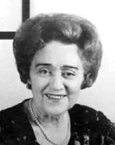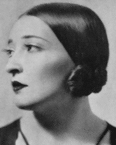Posted by Bob Sherman, November, 2017
- It’s been a difficult pregnancy – a lot of delicate engineering work was involved, including the use of two modern-age computer programs that are completely beyond my ken – but Nadia Reisenberg’s highly acclaimed recordings of 6 Haydn Sonatas and the complete Variations have been completely re-mastered from the session tapes by Seth Winner, and the resulting two-CD album (encompassing what actually required three separate LPs back in the 1950’s) will be born before the end of the year. The sound is amazingly warm, clear, and true-to-life in conveying what John Sweeney, reviewing the original Westminster LP in 1958, called “Miss Reisenberg’s rare affinity for Haydn, her touch light but not superficial, her technique clean and pearly.”
Gramophone Magazine, reviewing the earlier two-CD release of live chamber performances (Roméo 7318/19) praised “the enormously high quality of the music-making,” and referring to the home solo pieces included on the same set, cited the “unbridled playing, full of panache. Listen ‘blind’ and you could as well be eavesdropping on an unreleased recording by some big name virtuoso.”
Late News Flash:
- Barely a week into January, and already I have to interrupt myself to alert you to a long and highly detailed review of the now-released Haydn album by Gary Lemco. It’s headlined, “Nadia Reisenberg’s 1950’s Haydn program receives new and astonishingly clear gloss from Roméo Records.” Within it we read that “Each of the sets of variations demonstrates both the composer’s inventive spontaneity and Reisenberg’s deft arsenal of keyboard technique: sturdily aggressive, focused, and eminently clear in architectural delivery.” Gary examines most of the variations and each of thee sonatas in turn, offering similarly extravagant praise, and ending by saying that “Reisenberg invests the finale (of the Sonata #60) with mirth, music-box clarity,and eminently polished elan.” Gary Lemco is also planning to devote one of his Los Angeles radio programs to this and other NR performances.
- Even more gratifying was Scott Noriega’s extended review (about the length of this newsletter) in Fanfare Magazine. Here are a few excerpts:
“What is most notable is the pianist’s lush and beautiful tone, her attention to even the slightest details (just behold her articulations in the Weber Grand Duo—her pianism is breathtaking!), or her astonishing technique, but also her ability to play with any combination of musicians equally well.”
“The Dvorak Quintet … was recorded right near the end of Reisenberg’s life, but never are her abilities in question here. Her runs throughout are as smooth and assured as they had been 30 years earlier.”
“The real tour de force is Reisenberg’s rendition of the Liszt Spanish Rhapsody, a work as flamboyant and outwardly virtuosic as his Hungarian Rhapsodies — probably even more so! And hers is now among my favorite performances of this piece.”
“You will never listen to some of these works in the same way again — that I can promise.”
- It took a couple of years, but Rob Barnett’s perceptive review of an earlier NR re-release appeared recently in Music Web International:
“The gracious playing of (Paul) Doktor and (Nadia) Reisenberg radiates outwards in the first of the two (Brahms) sonatas. The Andante of No. 1 has a Bach-like serenity. The Second Sonata adopts a vulnerable Kreislerian smile, but here Reisenberg finds the sort of craggy drama encountered in the First Piano Concerto.”
- A year ago, former NR student Roman Markowicz devoted two broadcasts on Polish Radio to her Chopin performances. This past summer, he explored her recordings of Russian repertoire, plus some chamber music and Mozart. “Ah, Mozart with the Great Nadia,” Roman wrote me, “I still adore her recordings (with Artur Balsam) of the Four-Hand Sonatas, and I recall Balsam fondly telling me that she was the greatest sight-reader. Actually they both were. I had the LPs de-clicked, so we can listen with complete admiration.”
- The late Kenneth G. Mills was primarily known as a choral conductor, composer and founder of the innovative Star-Scape Singers, but he was also a fine pianist, and I recently learned that he had studied with NR for three years in the 1950’s. “Nadia Reisenberg was one of the most formative teachers I ever had,” Dr. Mills wrote in his memoirs, “I learned so much from her.”
- Another literary note arrived courtesy of Michael Shapiro, composer and music director of the Chappaqua Orchestra. “I’m reading Sergei Rachmaninoff: A Lifetime in Music by Sergei Bertensson,” Michael wrote, “and wanted to share this quote with you:”
“In mid-December, Rachmaninoff was pleased to hear a radio performance from New York’s WQXR of his sonata for piano and cello, played by Nadia Reisenberg and Joseph Schuster. He telephoned Miss Reisenberg to praise the interpretation and the tempi of the performance, but also to remind her that the work is not for cello with piano accompaniment, but for two instruments in equal balance.”
I hardly think she needed that information, but Yusia (as Russians called him) was never totally convinced, and apparently neither was the studio engineer that night.
- Susan Barry, manager of communications at Mannes College, is finishing up a video about Myung-Whun Chung, which will include one or more photos of the conductor-pianist when he studied there with NR. This, of course, was back when Mannes was in the old mansion building on East 74th Street.
Moving on to theremin topics, interest continues in Clara Rockmore’s historic role in the acceptance of the theremin as a legitimate concert instrument (as opposed to its usual movie role as sound-effect partner to space aliens or earthling psychotics). Among other planned happenings next year and beyond, a documentary by Lisa Rovner about women who have been at the helm and heart of electronic music development (with the catchy title “Sisters with Transistors”) will include commentaries and performances by Clara.
- Natxo Leuza, director of a documentary about children’s psychological and physical abuse in Zambia, has asked to use Clara and Nadia’s performance of Rachmaninoff’s Vocalise, presumably for a scene extoling the healing power of music.
Another Late News Flash:
Just before the end of December, 2017, Eric Grundhauser put forth a long article about Clara for the online service Atlas Obscura. Headlined “5 Secrets for mastering the theremin from the legendary Rockmore,” his admiring article includes several video clips of her performances, and as the title suggests, a skillful summary of the exercises Clara wrote, and advice she offered to “future thereminists.” They were dedicated to the late Robert Moog, and when you purchase a Moog theremin, a complimentary copy, including sketches of suggested finger positions, is included.
- The prize-winning composer Dalit Warshaw presented a new transcription of Nizk’orah (the Hebrew title translates more or less as “We Remember Her”). Originally scored for theremin, cello and piano, it was written for a memorial concert honoring Clara which took place at Steinway Hall on March 22, 2001. And says Dalit:
“I had known Clara for much of my life, from when I was six years old until her death in May, 1998. As both theremin teacher and friend, she continued to be one of the more potent inspirational figures in my life, both musically and personally. During the course of the work, I refer to some of Clara’s most well-known recordings: one might recognize wisps of the Vocalise by Rachmaninoff, and The Swan by Saint-Saens. It is as though a continuation of Clara’s song is taking place, but one heard filtered through something of the beyond, over the River Styx.”
During her year as a Guggenheim fellow, Dalit Warshaw also completed a Theremin Concerto for Carolina Eyck, with a projected premiere in 2019. That year will mark the centennial of the instrument’s invention by Lev Termen (or as he was known in America, Leon Theremin), and a number of celebratory events are planned to mark the occasion. The new concerto, Dalit wrote me, “presents the theremin in the aesthetic and manner of lyricism intended for it by Termen, and, I believe, Clara. Indeed, the first movement, subtitled ‘Clara’s Violin’ gives a musical narrative of aspects of her story, and her introduction to the theremin.”
Can’t wait…


